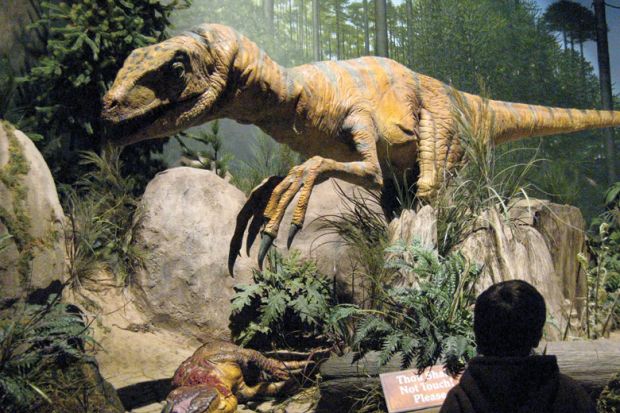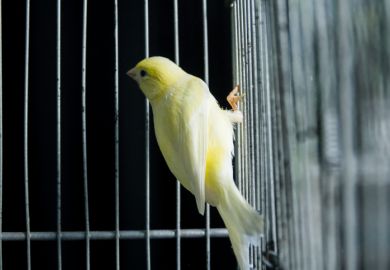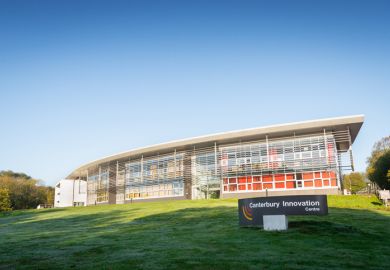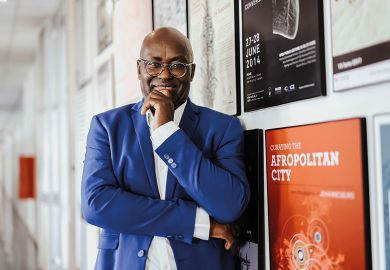If you believe in evolution, billion-year-old fossils and heliocentric astronomy, the idea of a creation museum may well induce eye-rolling derision at the fanatical American fundamentalists who inhabit an alternative and unbridgeable reality.
But Susan and William Vance Trollinger, married scholars (of English and history, respectively) at the University of Dayton, 70 miles from the Petersburg, Kentucky museum, do not ridicule this cultural phenomenon (as, for example, A. A. Gill did in Vanity Fair: “It is irredeemably kitsch…This cheap county-fair sideshow – this is their best shot?”). Perhaps the Trollingers assume that we readers will supply such disparagement ourselves. But their academic detachment and methodical critical assessment offer the best way to penetrate the topic. “As bizarre as the museum may seem to many Americans,” they write, “what happens inside its doors matters to all of us.”
Creationism posits that “the account of origins presented in Genesis [chapters 1-11] is a simple but factual presentation of actual events”. Cain, thus, began populating the world when he married his sister – incest was necessary and acceptable back then, the museum explains – and dinosaurs boarded the Ark (being coterminous with humans, as dragon legends prove, because obviously dragons were really dinosaurs). The museum disseminates “young earth” creationism, a relatively recent orthodoxy. Even William Jennings Bryan from the Scopes “monkey trial” was an “old earth” or “day-age” creationist, a belief fairly compatible with mainstream geology that construed a “day” in Genesis as an “age” of unspecified duration.
Righting America at the Creation Museum ethnographically examines the institution, which opened in 2007: the authors attended frequently, taking pictures, watching videos and other media displays, reading informational placards and analysing the crowds to assess the museum’s cultural, theological, political and rhetorical perspectives. “Righting America” – the Trollingers’ assessment of the museum’s raison d’être – involves both “correcting” America’s drift away from absolute faith in biblical inerrancy and also championing the right-wing faction of the interminable culture wars. One might have thought that sustained exposure to this worldview would raise the hackles (and blood pressure) of an academic readership, but in fact the material unfolds engagingly because the Trollingers confront and rebut pseudoscientific zealotry on our own ground, our own terms. They challenge these ideologies by maximally understanding, dissecting and exposing them, so readers emerge from our deep exposure to this culture feeling triumphant, sane, as we align with the authors in the camp of reason and science. (This reaction reflects my own orientation, of course: a creationist reader would likely have a different response, which I will not presume to imagine.) The book is not intellectually angry, as it well might have been had the authors allowed themselves to get dragged into the fray of the territory that the museum stakes out. The project does, nevertheless, leave them finally dispirited. “Sad indeed,” the last chapter ends. “For all of us.”
Should an institution so polemically extreme even be considered a museum? Critics have called it an avatar of Disney, a “museum of misinformation”, an “anti-museum”, a “rebuttal museum” and a “haunted house”. But the Trollingers pointedly begin by discussing the history and style of museums – architecturally, organisationally, pedagogically – presuming that, while this one is quite unlike most others, it is nevertheless full of dioramas, display cases, artefacts, explanatory signage and a keen schema of information design. I agree with their premise that its own calculated representation of itself as a museum invites us to read and respond to it as such.
Righting America offers a detailed tour through displays, theatres, an archaeological diorama, a planetarium and an insectarium, among other experiences. The “Biblical Authority” room offers life-size models of Isaiah, Moses and David; a recreation of the Garden of Eden includes animatronic dinosaurs. One room depicts the construction of Noah’s Ark and its voyage; another, titled “Flood Geology”, explains how all the apparently “aged” physical features of the Earth, including fossils, were actually created during God’s six-day labour, 6,000 years ago.
The “Cave of Sorrows” depicts ramifications of original sin, including a drug addict injecting himself and also a mushroom cloud from an atomic explosion. In a similar vein, the “Culture in Crisis” exhibit resembles the “Hell Houses” that evangelicals commonly stage for Halloween, where actors traumatise visitors into internalising the horrific consequences of premarital sex, abortion, drugs and pornography. All these, along with school shootings, the 9/11 attacks, Islamic terrorism, stem cell research, same-sex marriage and, of course, the evolutionary brainwashing conducted in public schools are presented as consequences of failing to embrace creationism. Again and again, museum-goers are told, the choice is yours: reason and science (“lies”), or the authority of God’s inerrant word.
The Trollingers also discuss what is not there: it surprises them to find no actual Bibles for visitors to read, and when biblical passages do appear in displays they are not infrequently edited, elided, misquoted and/or misleadingly decontextualised.
A small part of me wanted to hit the road and see at first hand what all this looks like up close. But the Trollingers have provided a service by writing this book so that we do not have to go there ourselves. (They describe responses from unlikely patrons: a Jewish group felt “despondency…aching fear”, and lesbian visitors felt “glared at, unwelcomed, and generally tense” amid “homophobic surveillance”.)
The Creation Museum is but the tip of the iceberg in American fundamentalism, and the authors go deep beneath the surface to explore the organisations and the ideological agendas lying beneath this public display. The man behind the curtain, the museum’s founder and president, Ken Ham, also heads Answers in Genesis (AiG), which claims to be the world’s largest apologetics (“ie, Christianity-defending”) organisation.
The Trollingers extensively survey 20th- and 21st-century currents in American evangelicalism that culminate in Ham’s museum, writings, websites, public debates and lectures. An Australian immigrant to the US, Ham was previously a science teacher who became infuriated because students believed that their textbooks’ explanation of evolution proved the Bible untrue. He began speaking locally, then internationally, in support of young earth creationism and in opposition to the “almost unspeakable cultural decadence” resulting from “the forces of atheistic humanism” that denied the truth of the Genesis story. AiG, launched in 1994, became “a creationist juggernaut”: a portal to missionary activism, books and journals, podcasts, cartoons, radio plays, school curricula, merchandise and apparel, travelling exhibitions and, front and centre, the Creation Museum.
I frequently wondered, as I read this book: who are these millions of museum-goers, and how can they live in the same country as me? I have had the same thoughts lately about Donald Trump’s political base. The book does not mention the Republican presidential candidate, who is not, as far as I know, a creationist himself. But Trump, who taps into a comparably incendiary bundle of arbitrary delusions with manifestly reactionary implications, could not be as successful as he has been unless a significant mass of Americans were – just as the Trollingers demonstrate – willing to support policies and ethics predicated upon self-serving, ludicrously untenable narratives. (While the Trollingers do not enumerate the size of this demographic, a 2014 Gallup poll found that 42 per cent of Americans believed in creationism rather than evolution.) Trumpism is the extrapolation of the Creation Museum, and Righting America is right, America: we need to figure out – and quickly! – what is going on here.
Randy Malamud is Regents’ professor of English at Georgia State University, and author of The Importance of Elsewhere: The Globalist Humanist Tourist (in press).
Righting America at the Creation Museum
By Susan L. Trollinger and William Vance Trollinger, Jr.
Johns Hopkins University Press, 344pp, £17.50
ISBN 9781421419510 and 9534 (e-book)
Published 30 June 2016
The authors
 “This will seem hopelessly romantic, but there were very few challenges in co-authoring this book, and many pleasures,” says William Trollinger, professor of history at the University of Dayton.
“This will seem hopelessly romantic, but there were very few challenges in co-authoring this book, and many pleasures,” says William Trollinger, professor of history at the University of Dayton.
“Division of labour is certainly a plus – the book got completed much more quickly! – but it is much more important to have very similar intellectual commitments, which we certainly have. And my co-author corrects my tendency to be too cryptic, and I correct her tendency to be too loquacious!”
Born in Maryland and raised in Colorado, he was not a studious child. “I skipped classes a lot (to play golf), I found myself in the principal’s office a lot and I was not overly concerned with what my teachers wanted me to do. On the other hand, I loved books, and when I wasn’t playing sports or getting into trouble, I was reading.”
His Righting America co-author and wife, Susan Trollinger, associate professor of English at Dayton, was born and raised in the city. “I am a Midwestern girl. I think that my upbringing has something to do with the fact that I like to work, I love jazz and I hope that Bill’s and my book will have something of a wide readership.”
As a child, she recalls, “I always loved school and struggled with summer breaks. Getting prepared for a new academic year has been a blast for me since elementary school. You just cannot beat new books, new pens and (now, best of all) new students.”
Offered the chance to change one thing about higher education, what would they choose?
William, who “came of age in the late 1960s, which taught me that it is incumbent on all of us to be very sceptical of the claims of those in authority”, replies: “I would resist or reject the corporate model that is so prevalent in US higher education, in the process giving much more priority to the humanities. I am fortunate to be at the University of Dayton, which – thanks to its commitment to the Catholic intellectual tradition – continues to require undergraduates to take a good number of courses in the humanities.”
Susan’s choice, she says, is a “super simple” one. “I’d reduce class size across the board. We are blessed at Dayton to have a lot of faculty who love to teach. And if they were given smaller class sizes so that they could really spoil their students with their time and attention, I know that would be transformative for everyone.”
Karen Shook
POSTSCRIPT:
Print headline: By ‘Flood Geology’, we sat down, yea, we wept
Register to continue
Why register?
- Registration is free and only takes a moment
- Once registered, you can read 3 articles a month
- Sign up for our newsletter
Subscribe
Or subscribe for unlimited access to:
- Unlimited access to news, views, insights & reviews
- Digital editions
- Digital access to THE’s university and college rankings analysis
Already registered or a current subscriber? Login




